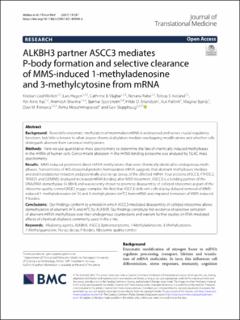| dc.contributor.author | Wollen, Kristian Lied | |
| dc.contributor.author | Hagen, Lars | |
| dc.contributor.author | Vågbø, Cathrine Broberg | |
| dc.contributor.author | Rabe, Renana | |
| dc.contributor.author | Iveland, Tobias Solli | |
| dc.contributor.author | Aas, Per Arne | |
| dc.contributor.author | Sharma, Animesh | |
| dc.contributor.author | Sporsheim, Bjørnar | |
| dc.contributor.author | Erlandsen, Hilde O. | |
| dc.contributor.author | Palibrk, Vuk | |
| dc.contributor.author | Bjørås, Magnar | |
| dc.contributor.author | Fonseca, Davi de Miranda | |
| dc.contributor.author | Mosammaparast, Nima | |
| dc.contributor.author | Slupphaug, Geir | |
| dc.date.accessioned | 2022-03-04T11:36:17Z | |
| dc.date.available | 2022-03-04T11:36:17Z | |
| dc.date.created | 2021-12-14T07:35:26Z | |
| dc.date.issued | 2021 | |
| dc.identifier.citation | Journal of Translational Medicine. 2021, 19 (1), . | en_US |
| dc.identifier.issn | 1479-5876 | |
| dc.identifier.uri | https://hdl.handle.net/11250/2983113 | |
| dc.description.abstract | Background: Reversible enzymatic methylation of mammalian mRNA is widespread and serves crucial regulatory functions, but little is known to what degree chemical alkylators mediate overlapping modifcations and whether cells distinguish aberrant from canonical methylations. Methods: Here we use quantitative mass spectrometry to determine the fate of chemically induced methylbases in the mRNA of human cells. Concomitant alteration in the mRNA binding proteome was analyzed by SILAC mass spectrometry. Results: MMS induced prominent direct mRNA methylations that were chemically identical to endogenous methylbases. Transient loss of 40S ribosomal proteins from isolated mRNA suggests that aberrant methylbases mediate arrested translational initiation and potentially also no-go decay of the afected mRNA. Four proteins (ASCC3, YTHDC2, TRIM25 and GEMIN5) displayed increased mRNA binding after MMS treatment. ASCC3 is a binding partner of the DNA/RNA demethylase ALKBH3 and was recently shown to promote disassembly of collided ribosomes as part of the ribosome quality control (RQC) trigger complex. We fnd that ASCC3-defcient cells display delayed removal of MMSinduced 1-methyladenosine (m1A) and 3-methylcytosine (m3C) from mRNA and impaired formation of MMS-induced P-bodies. Conclusions: Our fndings conform to a model in which ASCC3-mediated disassembly of collided ribosomes allows demethylation of aberrant m1A and m3C by ALKBH3. Our fndings constitute frst evidence of selective sanitation of aberrant mRNA methylbases over their endogenous counterparts and warrant further studies on RNA-mediated efects of chemical alkylators commonly used in the clinic. | en_US |
| dc.language.iso | eng | en_US |
| dc.publisher | BMC | en_US |
| dc.rights | Navngivelse 4.0 Internasjonal | * |
| dc.rights.uri | http://creativecommons.org/licenses/by/4.0/deed.no | * |
| dc.title | ALKBH3 partner ASCC3 mediates P-body formation and selective clearance of MMS-induced 1-methyladenosine and 3-methylcytosine from mRNA | en_US |
| dc.type | Peer reviewed | en_US |
| dc.type | Journal article | en_US |
| dc.description.version | publishedVersion | en_US |
| dc.source.pagenumber | 0 | en_US |
| dc.source.volume | 19 | en_US |
| dc.source.journal | Journal of Translational Medicine | en_US |
| dc.source.issue | 1 | en_US |
| dc.identifier.doi | 10.1186/s12967-021-02948-6 | |
| dc.identifier.cristin | 1968006 | |
| cristin.ispublished | true | |
| cristin.fulltext | original | |
| cristin.qualitycode | 2 | |

